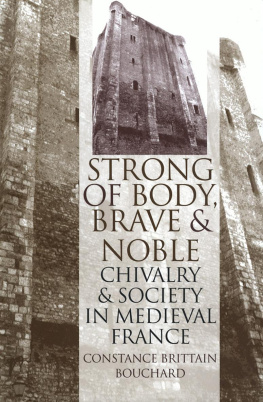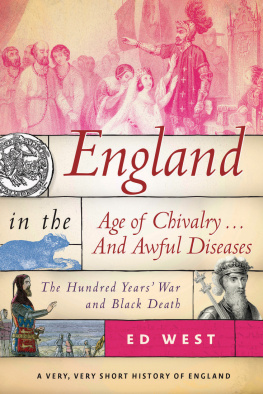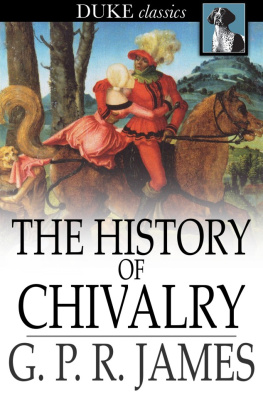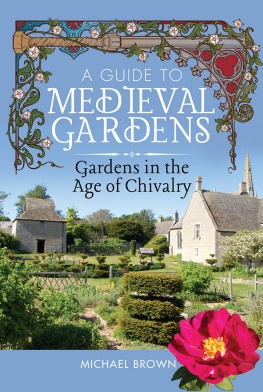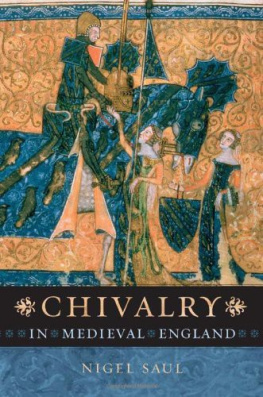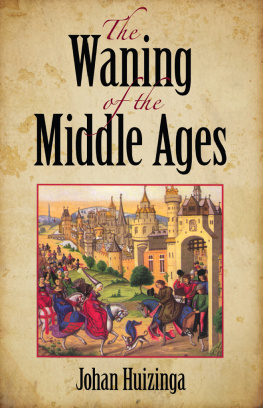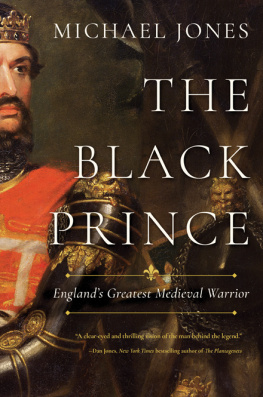PREFACE
Strong of body, brave and noble, ran the description of an idealized lord in the twelfth-century epic The Coronation of Louis. Medieval aristocrats prided themselves on their prowess, their courage, and their noble birth. They wielded great power, and they were fascinated by what was required to acquire and keep that power. Repeatedly, especially in their fictional literature, almost all of which turned on exploits of the brave and wellborn, they tried to create an idealized image of nobility and knighthoodand yet kept discovering that every ideal was shot full of contradictions. In this book, I examine both the position of knights and nobles in the society of the High Middle Ages and the images of those positions created at that time.
The medieval aristocracy, especially that of France, has been the subject of a great deal of study during the last generation. Scholars have reexamined and redefined the roots of noble status, the relationship between nobles and knights, the part the aristocracy played in both rural and urban economies, the origins of chivalry, the meaning of feudalism, the nobilitys role in church reform, and the ties between kings and their great nobles. Regional and local studies have challenged older timetables and definitions. Yet while scholarly understanding of these topics has changed markedly, their presentation in general survey works has not. Most recent studies of chivalry and nobility are highly technical, very narrowly focused, and published in specialized journals, often in French and German. Such work is not always easily accessible to the English-speaking scholar. In addition, specialists in literature and specialists in history have sometimes been ignorant of each others work. In this study of the nobility in high medieval France I hope to tie together many of these recent findings (including some of my own work) and to provide an introduction to medieval nobility and chivalry in a form accessible both to scholars and to students of medieval history and literature.
During the High Middle Ages, the eleventh through early thirteenth centuries, French aristocratic culture was especially influential, and not just in France. In England after the Norman Conquest of 1066, French culture permeated the highest social circles. The same was true, though to a lesser degree, in the Spanish peninsula as the reconquista against the Muslims gradually worked its way south; the first king of Portugal was descended from the dukes of Burgundy, and the twelfth-century kings of Spain were descended from the counts of Burgundy and Macon. Although German aristocrats had long-standing traditions of their own, they adopted many elements of French chivalry during this period.
This books central focus is high medieval France, but in several instances I look back before the eleventh century or forward after the middle of the thirteenth century, and I sometimes compare developments in France with those in neighboring areas. The High Middle Ages was chosen both because it is the period with which I am most familiar and because this period has not received enough attention. Most other studies of chivalry still stress the late Middle Ages, but it is not safe to assume that one can read the twelfth century back from the fifteenth. The term France is used here roughly to describe that area of the Continent in which the population spoke French. Thus it corresponds neither to the modern-day French Republic, which includes some areas (such as Alsace) that were not French speaking in the Middle Ages, nor to the medieval Kingdom of the Franks, which did include French-speaking Flanders (now part of Belgium) but not some other areas (such as the Jura) where French was spoken. Southern France, or Occitania, separated linguistically but not politically from the French kingdom, is included, but only peripherally.
Throughout this book I work from a conviction that one cannot create tidy definitions and then attempt to apply them to the past. In the late twentieth century many social institutions, such as the middle class, cannot be explained in twenty-five words or fewer, and yet everyone knows them when they see them. In just the same way, there were no consistent definitions in the High Middle Ages of such key institutions as nobility, chivalry, fief holding, or the church, even though contemporaries certainly recognized and discussed them. It is also important to keep in mind that what people recognized when they saw it changed over time, so that one set of definitions cannot be applied to the 250 years covered by this book, much less to the entire Middle Ages. The study of medieval nobility and chivalry has sometimes bogged down in rather sterile semantic discussions about, for example, whether classic feudalism reached an area late, or whether a poem reflects the ethos of courtly lovequestions that presume preexisting and essentially unchanging standards to which one can compare local political institutions or a particular poets use of imagery. Rather than try to create or impose simple models of medieval institutions, I believe, one should try to understand the people of the past and what they thought they were doing in a vital and ever-shifting social context.
Because this book is meant to be an introduction, I have for the most part done no more than suggest the complex historiographical debates that swirl around many of the topics I am addressing. I have made no attempt to be exhaustive in citing the extensive scholarly literature. To keep down the bulk of footnotes, I have reserved full references for the bibliography, where I have also added a few annotations to signal some of the most significant studies. Similarly, I have where possible cited worksboth primary and secondaryin easily accessible English translations.
This book begins with an attempt to define the nobility: who were they, how were they recognized, what functions did they fill, and how were they different from knights? In the second chapter, I put the nobles in their social context, including their relations with kings at one end of the social spectrum and with peasants at the other. Previous studies of nobility and chivalry have done little more than hint at the rural economy in which lords functioned; yet I think it is important to discuss at least briefly those from whom noble wealth derived. In this chapter I also deal with the thorny question of the nature of feudalism. In Chapter 3 I address the structure of noble families more fully, including their marriages and the round of their lives. Chapter 4 is devoted to the literature that nobles read and responded to, especially works that involved chivalrous behavior and love. The book ends with a chapter on the interactions between the nobility and the church, a topic that has attracted intensive scholarly attention in recent years.
In graduate school I was greatly influenced by Sidney Painters French Chivalry, first published in 1940, and the present book is to some degree a tribute to that work. A recent survey done by the Consortium for the Teaching of the Middle Ages indicates that it is still the most commonly assigned book on the topic of chivalry. Nearly sixty years have passed since Painters book first appeared, however, and during that time, scholars have drastically redefined both nobility and chivalry. Though Painters book is no longer an adequate introduction to the topic, its wit and clarity have kept it continuously in print. If my own work is not always as lively, I hope that at least I have learned Painters lesson to keep the telling of history as interesting as the subject matter.


